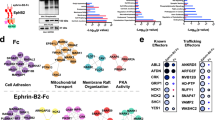Abstract
Recent studies in our laboratory demonstrate that ligand-mediated activation of the EphA8 receptor critically regulates cell adhesion and migration. In this report, we show that the EphA8 receptor induces neurite outgrowth in NG108-15 cells in the absence of ligand stimulation. Using various deletion mutants lacking specific intracytoplasmic regions, we confirm that the tyrosine kinase domain of EphA8 is important for inducing neurite outgrowth. However, the tyrosine kinase activity of EphA8 is not crucial for neurite outgrowth induction. Treatment with various inhibitors further reveals that the mitogen-activated protein kinase (MAPK) signaling pathway is critical for neurite outgrowth induced by EphA8. Consistent with these results, EphA8 expression induced a sustained increase in the activity of MAPK, whereas ligand-mediated EphA8 activation had no further modulatory effects on MAP kinase activity. Additionally, activated MAPK relocalized from the cytoplasm to the nucleus in response to EphA8 transfection. These results collectively suggest that the EphA8 receptor is capable of inducing a sustained increase in MAPK activity, thereby promoting neurite outgrowth in neuronal cells.
This is a preview of subscription content, access via your institution
Access options
Subscribe to this journal
Receive 50 print issues and online access
$259.00 per year
only $5.18 per issue
Buy this article
- Purchase on Springer Link
- Instant access to full article PDF
Prices may be subject to local taxes which are calculated during checkout








Similar content being viewed by others
References
Becker E, Huynh-Do U, Holland S, Pawson T, Daniel TO and Skolnik EY . (2000). Mol. Cell. Biol., 20, 1537–1545.
Choi S, Jeong J, Kim T and Park S . (1999). Mol. Cells, 9, 440–445.
Choi S and Park S . (1999). Oncogene, 18, 5413–5422.
Coulthard MG, Duffy S, Down M, Evans B, Power M, Smith F, Stylianou C, Kleikamp S, Oates A, Lackmann M, Burns GF and Boyd AW . (2002). Int. J. Dev. Biol., 46, 375–384.
Elowe S, Holland SJ, Kulkarni S and Pawson T . (2001). Mol. Cell. Biol., 21, 7429–7441.
Gendron L, Oligny JF, Payet MD and Gallo-Payet N . (2003). J. Biol. Chem., 278, 3606–3614.
Gu C and Park S . (2001). Mol. Cell. Biol., 21, 4579–4597.
Gu C and Park S . (2003). FEBS Lett., 540, 65–70.
Himanen JP and Nikolov DB . (2003). Int. J. Biochem. Cell Biol., 35, 130–134.
Holland SJ, Gale NW, Gish GD, Roth RA, Songyang Z, Cantley LC, Henkemeyer M, Yancopoulos GD and Pawson T . (1997). EMBO J., 16, 3877–3888.
Jeong J, Choi S, Gu C, Lee H and Park S . (2000). DNA Cell Biol., 19, 291–300.
Klein R . (2001). Curr. Opin. Cell Biol., 13, 196–203.
Koo J, Shim S, Gu C, Yoo O and Park S . (2003). Dev. Dyn., 226, 596–603.
Kullander K and Klein R . (2002). Nat. Rev. Mol. Cell Biol., 3, 475–486.
Kuo WL, Abe M, Rhee J, Eves EM, McCarthy SA, Yan M, Templeton DJ, McMahon M and Rosner MR . (1996). Mol. Cell. Biol., 16, 1458–1470.
Mellitzer G, Xu Q and Wilkinson DG . (2000). Curr. Opin. Neurobiol., 10, 400–408.
Miao H, Wei BR, Peehl DM, Li Q, Alexandrou T, Schelling JR, Rhim JS, Sedor JR, Burnett E and Wang B . (2001). Nat. Cell Biol., 3, 527–530.
Nelson P, Christian C and Nirenberg M . (1976). Proc. Natl. Acad. Sci. USA, 73, 123–127.
Park S, Frisen J and Barbacid M . (1997). EMBO J., 16, 3106–3114.
Park S and Sanchez MP . (1997). Oncogene, 14, 533–542.
Pratt RL and Kinch MS . (2002). Oncogene, 21, 7690–7699.
Schmucker D and Zipursky SL . (2001). Cell, 105, 701–704.
Tepass U, Godt D and Winklbauer R . (2002). Curr. Opin. Genet. Dev., 12, 572–582.
Tong J, Elowe S, Nash P and Pawson T . (2003). J. Biol. Chem., 278, 6111–6119.
Vaudry D, Stork PJ, Lazarovici P and Eiden LE . (2002). Science, 296, 1648–1649.
Vindis C, Cerretti DP, Daniel TO and Huynh-Do U . (2003). J. Cell Biol., 162, 661–671.
Wilkinson DG . (2001). Nat. Rev. Neurosci., 2, 155–164.
Yan M and Templeton DJ . (1994). J. Biol. Chem., 269, 19067–19073.
Acknowledgements
We thank Dr Henkemeyer for providing a full-length EphB2 cDNA. This work was supported by a Korea Research Foundation Grant (KRF-2002-005-C00014) and also partially by a grant (M103KV010010 03K2201 01030) from Brain Research Center of the 21st Century Frontier Research Program funded by the Ministry of Science and Technology of Republic of Korea.
Author information
Authors and Affiliations
Corresponding author
Rights and permissions
About this article
Cite this article
Gu, C., Shim, S., Shin, J. et al. The EphA8 receptor induces sustained MAP kinase activation to promote neurite outgrowth in neuronal cells. Oncogene 24, 4243–4256 (2005). https://doi.org/10.1038/sj.onc.1208584
Received:
Revised:
Accepted:
Published:
Issue Date:
DOI: https://doi.org/10.1038/sj.onc.1208584
Keywords
This article is cited by
-
NLRP3/miR-223-3p axis attenuates neuroinflammation induced by chronic intermittent hypoxia
Functional & Integrative Genomics (2023)
-
The oncocytic subtype is genetically distinct from other pancreatic intraductal papillary mucinous neoplasm subtypes
Modern Pathology (2016)
-
Eph receptors as therapeutic targets in glioblastoma
British Journal of Cancer (2014)
-
EphrinA5-EphA7 Complex Induces Apoptotic Cell Death Via TNFR1
Molecules and Cells (2013)
-
Endocytosis of EphA receptors is essential for the proper development of the retinocollicular topographic map
The EMBO Journal (2011)



